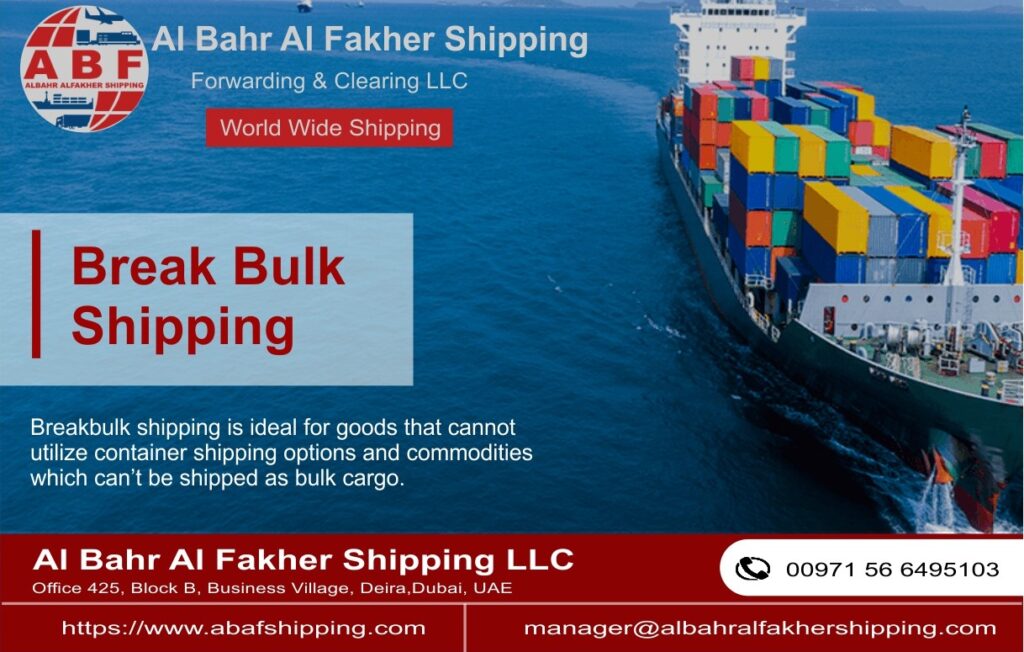Breakbulk shipment, also known as project cargo or non-containerized freight, has become too large to fit in typical containers. They are neither liquids nor dry aggregates.

What Is Break-Bulk Shipping? Everything You Need To Know About It
For moving their items, most businesses never have to look very far beyond the more convenient delivery options. They can load a container and ship their cargo via air or water. But how do you move your cargo from point A to point B if it is too large to fit in a container or too heavy to send by plane? Only break bulk shipping remains a viable alternative.
Since large cargo normally does not need to be decomposed to be loaded and sent, breakbulk shipping is the best alternative. On the other hand, it implies that reassembly is not required when they arrive.
Additionally, breakbulk transportation comprises complex freight, making coordination challenging. As a result, planning can be challenging if you don’t know what to anticipate.
This article will explain breakbulk transportation, how it operates, and how to deal with project cargo’s difficulties.
What Is Breakbulk Shipping?
Breakbulk shipment, also known as project cargo or non-containerized freight, has become too large to fit in typical containers. They are neither liquids nor dry aggregates.
Breakbulk shipping includes items like enormous engines or transformers, wind turbine elements like blades and structure elements, and construction machinery like large bulldozers.
Breakbulk transport is a fantastic choice for over-dimensional freight since you typically don’t need to break down products to load them onto a container. That implies that it’s also not required to assemble your goods once they arrive.
Additionally, as it is not containerized, a dock crane is not necessarily required to offload it. This provides you access to more port choices, such as Roll-On/Roll-Off (RoRo) shipment. Additionally, when delivering overseas, you just need a single bill of lading as everything is all in one piece.
Comparing Breakbulk & Bulk Shipping
If you’ve spent any amount of time at all in the global shipping community, you’ve probably heard of both bulk shipping and breakbulk shipping. What’s the distinction?
Bulk cargo is the process of transporting huge quantities of loose items on a cargo ship. The element of the two that involves loose commodities is hence the main distinction.
Grains, salt, sugar, sand, iron ore, and unmixed cement are examples of items that are typically shipped as dry bulk or as liquid bulk (like crude oil, petroleum, and vegetable oil).
Some products can’t be shipped as ordinary bulk cargo or fit within a vessel. This is the point where breakbulk shipping—which does have certain difficulties—might be something you want to take into account.
Issue Associated With Breakbulk Shipping And How To Fix Them
The best alternative for your large project cargo is often breakbulk shipment, however, there are certain frequent issues that you can encounter.
- Higher Risk of Damage
Breakbulk shipping frequently requires additional handling since it is huge and unusual. This raises the possibility of damage and/or violence. Breakbulk shipment technology advancements have made it possible to carry non-containerized freight fully covered and protected.
Before selecting a global breakbulk shipper, do your research to minimize risk and guarantee that your shipment will arrive safely and unharmed.
Seek out shipping companies in Dubai for project cargo who have a connection to a network with cutting-edge innovations. Your shipping company should also have a professional team who is familiar with the procedure and common risk areas so they can minimize them from the word go.
- Higher Costs
Breakbulk transportation is frequently more expensive than container-based shipping. This is due to the fact that carrying this kind of cargo requires extra handling and manpower.
It is more difficult to estimate expenses for breakbulk shipping because it is charged per metric ton or cubic meter, necessitating very precise measurements, weights, and descriptions of the shipment.
Often, savings in other areas might be used to compensate for those extra costs. Utilizing a seasoned global freight forwarder will help you keep within your budget and save unforeseen expenses.
Moreover, if you can give your global shipping partner accurate drawings and lifting guides, they can be quite useful during the planning and permission stages. They can also ensure that you get a more precise project quotation.
- Unavailability Of Breakbulk Vessels
Multifunctional vessel fleets don’t necessarily run on defined timetables, unlike container vessels. When you want to deliver your shipment, it might be challenging to get the proper kind of vessel in the ideal position.
The shipping strategy for your project might be handled by a reputable international shipping company. You might be able to book a space on ships that best suit the timeframe of your project courtesy their strong links with ocean freight carriers all around the world.
What Are Some Of The Benefits Of Breakbulk Shipping?
We have seen the issues related to breakbulk shipping, now we also need to look at some of the advantages of the breakbulk shipping strategy. Here are some of the benefits that breakbulk cargo offers:
- Ship Heavy Items without Breaking Them Down: Breakbulk cargo is advantageous for big or difficult-to-disassemble equipment and cargo. The shipper can transport the item as a whole as opposed to breaking it to fit into a container or bin. A breakbulk vessel normally has large capacity deck cranes and other tools required to load and offload these huge or hefty items.
- Less consolidation and reconsolidation: On a breakbulk vessel, like a barge or ship, the freight does not need to be disassembled or broken up into pieces. As a result, it might be a more cost-effective choice for shippers of huge freight. In the end, this results in a quicker delivery time.
- Separated containers: Breakbulk shipping does not necessitate the segregation of cargo into individual containers. Rather, to load the cargo, heavy or bulky objects are loaded using specialized machinery like cranes. Bulky products are now easier to move as a result.
Is Breakbulk Shipping Worth Having?
Although moving non-containerized freight is always a little more difficult than moving containers, new technologies are revolutionizing the way we think about moving breakbulk.
Despite its difficulties, breakbulk shipment is probably the best choice if you’re transporting big, bulky, high-value equipment or other project freight that won’t fit in a normal container.
